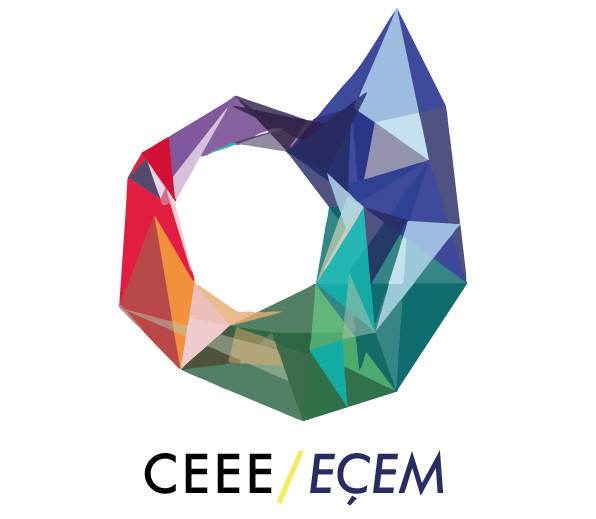Project Starting – Ending Dates: 01/10/2013 – 31/05/2018
Funded by: EU 7th Framework Programme
Project Budget: 12,000,000.00 € (EU Contribution: 8,645,352.00 €) / Özyeğin CEEE budget: 443,680 € (EU Contribution: 291,920 € ) / ADU budget: 1,066,920 € (EU Contribution: 564,210 €)/ ONU budget: 890,000 € (EU Contribution: 500,000 €)
Application Building: Faculty of Medicine Building, Adnan Menderes Uni., Aydın
Project Team: M. Pınar Mengüç, Yasemin Somuncu, Dilek Saygı, Cem Doğan Şahin, Haydar Mohammad, Tufan Akba
Project Partners: Turkey: CENTER FOR ENERGY, ENVIRONMENT AND ECONOMY (CEEE), ONUR ENERJI, ADNAN MENDERES UNIVERSITY (ADU)
Spain: ACCIONA, CARTIF. RANK, GEX, CEMOSA, TECNALIA
Italy: SOLTIGUA, EURAC, FBK
Belgium: AIRRIA GREEN VENTILATION, PROVINCE DE LIÈGE,
UNIVERSITY OF LIÈGE, YOURIS.COM
Germany: STEINBEIS EUROPA ZENTRUM
Poland: PURINOVA
Other people and organizations who contributed to BRICKER Project: CEEE/CEEE (Pınar Özuyar, Yasemin Somuncu, Nil Kutlar,
Cem Keskin, Dilek Saygı, Gülçin Mezireli, Cem Doğan Şahin,
Haydar Mohammed, Tufan Akba)
Aydın Adnan Menderes University (Yunus Çengel, Yunus
Çerçi, Atilla Dönük, Selman Sağlam)
Onur Energy (Onur Günduru, Emre Yaman)


REASON
BRICKER is a EUFP7 project carried out by CEEE. Its purpose was to effectively apply and generalize energy efficiency concepts through deep renovation in public buildings.
It is one of the pioneering, innovative and comprehensive renovation projects implemented in a complicated public building in the European Union using passive and active systems. The outcome of this demonstration project is to show that advanced energy solutions for largescale public buildings in different climate zones of Europe can be realized. The project had
- Turkish,
- Spanish,
- Italian,
- German,
- Polish and
- Belgian
and had the overreaching goal to reduce the energy requirement by at least 50%.
Within the scope of the project, two solution applications, one in Liege, Belgium and the other in Aydın, Turkey, have been successfully completed. The Faculty of Medicine building at Aydın Adnan Menderes University (ADU) in Turkey have been chosen for the application. It allowed a unique location where new technologies were developed and tested while passive and active solutions were demonstrated.
METHODOLOGIES
BRICKER Project aimed to design and apply active and passive energy efficiency systems in complex buildings. For the active solutions, systems were designed to simultaneously generate electricity from solar concentrating power systems and to be used for heating and cooling. Parabolic trough type collectors (PTC) are employed for this purpose and are combined with an innovative trigeneration system that uses solar energy, without emission.
This system has the capacity to collect 1400 kW of heat energy from the sun. The collected solar energy is converted into electricity with two Organic Rankine Cycle (ORC) units, each with a power of 75 kW, and the residual energy and directly collected solar energy from the ORC units are used for cooling in summer, heating and domestic hot water in winter. Cooling is provided by a thermally activated 254 kW (75 cooling ton) adsorption chiller, supported by waste heat from ORC units and excess heat collected from the sun.
The adsorption chiller supports existing electrical coolers in the hospital. It is the first use of equipment of this size in a public building in Turkey, and this solution was uniquely created in the Turkey implementation phase of the project. Easy maintenance, low operating cost and minimum internal energy consumption have been important factors in the choice of cooling technology.

IMPLEMENTATION
The BRICKER active-passive energy efficiency application developed for complex buildings makes Aydın Adnan Menderes University Faculty of Medicine Building one of the most progressive energy efficiency examples in the world. It is widely known that trigeneration systems use energy sources such as natural gas, fuel oil and coal as energy sources. The trigeneration system used together with the solar collecting system installed for BRICKER is unique in Turkey.
The system was designed to use the energy obtained from parabolic solar collectors spread over an area in the size of a football field for electricity, heating, and cooling. For this purpose, a series of operation scenarios were created under BRICKER.
In these scenarios, which vary depending on the daily sun and cloud conditions, solar energy at the level of 100-200 kW is considered as the threshold state and the system automatically prepares itself for immediate activity. If the solar energy provides 200-500 kW of solar energy, the system works, but only the first system (ORC 1) produces advanced electricity. If solar energy provides 500-1000 kW of energy, both electricity is generated from ORC 1, and it provides cooling in summer or heating in winter. If the solar energy provides 1000-1400 kW of energy, the system works fully, electricity is produced from both ORC 1 and ORC 2; In addition, cooling is provided in summer and heating in winter. A number of innovative applications were implemented for passive solutions. For example, a very special insulation material with very low thermal conductivity (0.038 W/m2K) and density (190 kg/m3) was used for the outer envelope of the hospital building. This application considerably reduces the cooling load of the building during the summer months.
SCENARIO 01
In case of insufficient sunlight (night or cloudy day), the plant is not operational, but is in a ready state to start working immediately;
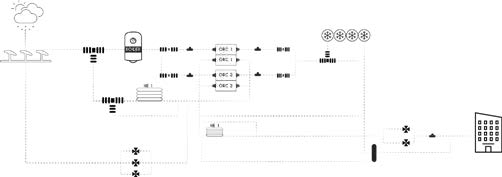
SCENARIO 03
If solar power supplies 100 – 200 kW, the system is ready for operation immediately (threshold state);
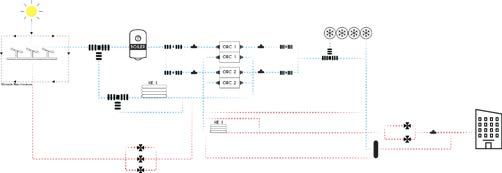
SCENARIO 05
If the solar energy provides 500 – 1000 kW of energy, the system works, generates electricity from ORC 1 and provides cooling in the summer or heating in the winter;
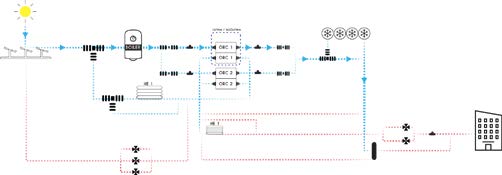
SCENARIO 02
If solar energy provides 0-100 kW of energy, sun rays are considered insufficient;
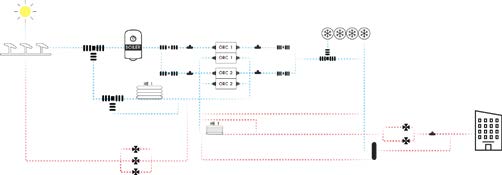
SCENARIO 04
If the solar power supplies 200 – 500 kW of solar energy, the system works and produces electricity only from ORC 1;
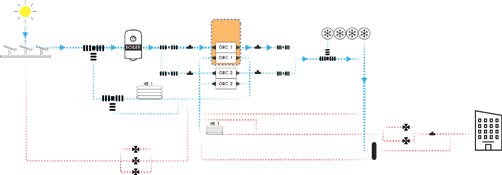
SCENARIO 06
If the solar energy provides 1000-1400 kW of energy, the system works, solar energy generates electricity from both ORC 1 and ORC 2 and provides cooling in summer or heating in winter.

IMPACT
With the BRICKER Project, a comprehensive system was put together to reduce energy consumption by at least 50% in a functioning public building. It was a scalable, repeatable, highly energy efficient, near zero emission and low cost application. It has a transparent and easily reproducible strategy for the design, construction and operation of renovation project towards deep energy reduction in public buildings. Potentially, it was shown to reduce the energy expenditure more than 500,000 € for the ADU Medical School building.
With the BRICKER Project, we aimed to reach a wide peer group at all levels in order to increase the quality of renovation and real estate value of lowenergy buildings in the region.
We also aimed to disseminate the results of this innovative, cost effective and high performance renovation concepts and solutions. With a doctoral dissertation completed by the CEEE student Haydar Mohammad during this study, the necessary integrated concepts for energy efficiency were also studied with scientific based. The BRICKER Project results have been presented at many conferences, and a number of scientific articles have been published.
BRICKER Project has also helped us to develop and complete the EUCAPACITYYENI NESIL and ISDB NEXTGEN projects that started later. BRICKER Project has received a major degree in Economy Field of IMSAD Investments in the Future Awards.
